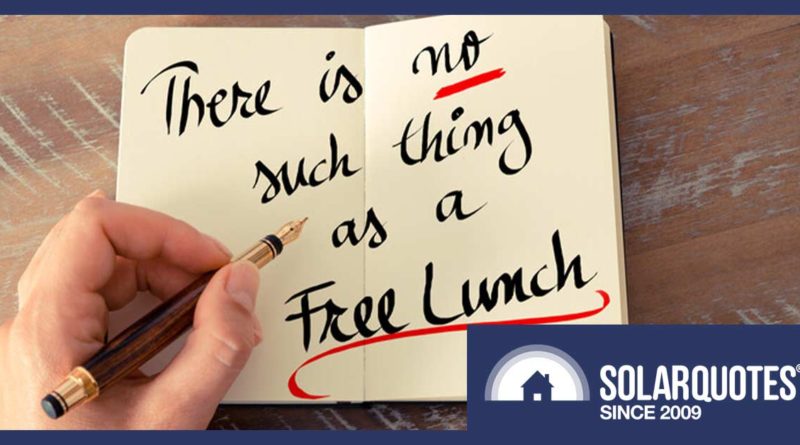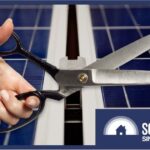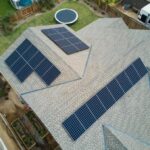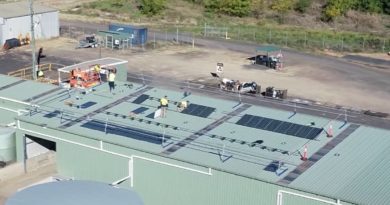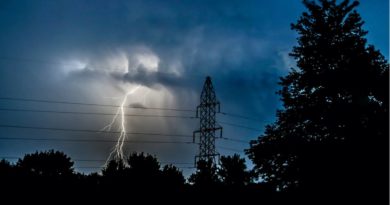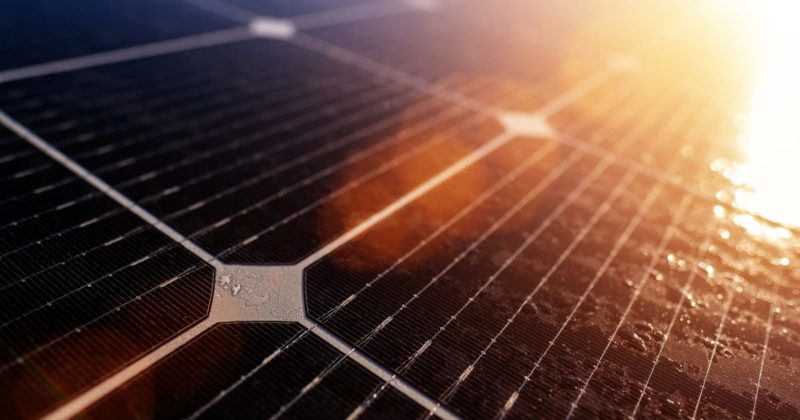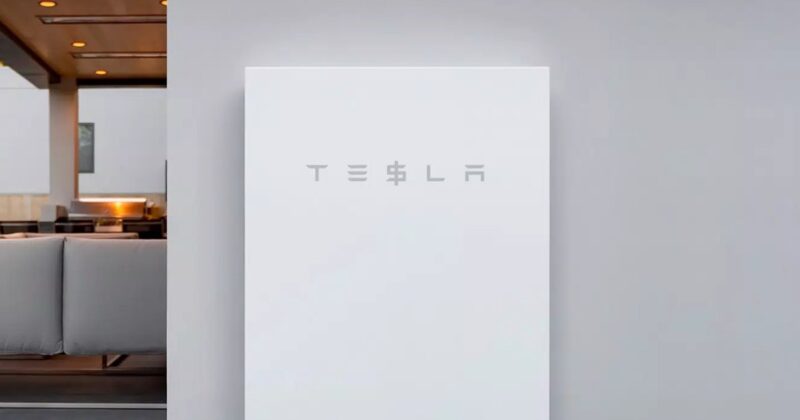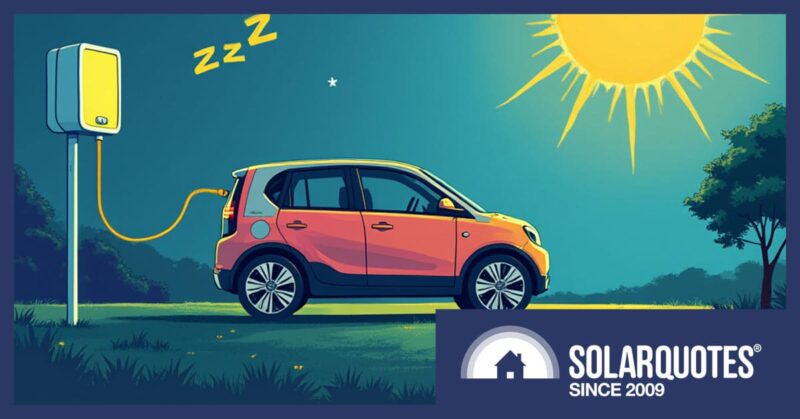EnergyAustralia Solar Home Bundle: Free Solar & Battery Comes At High Cost
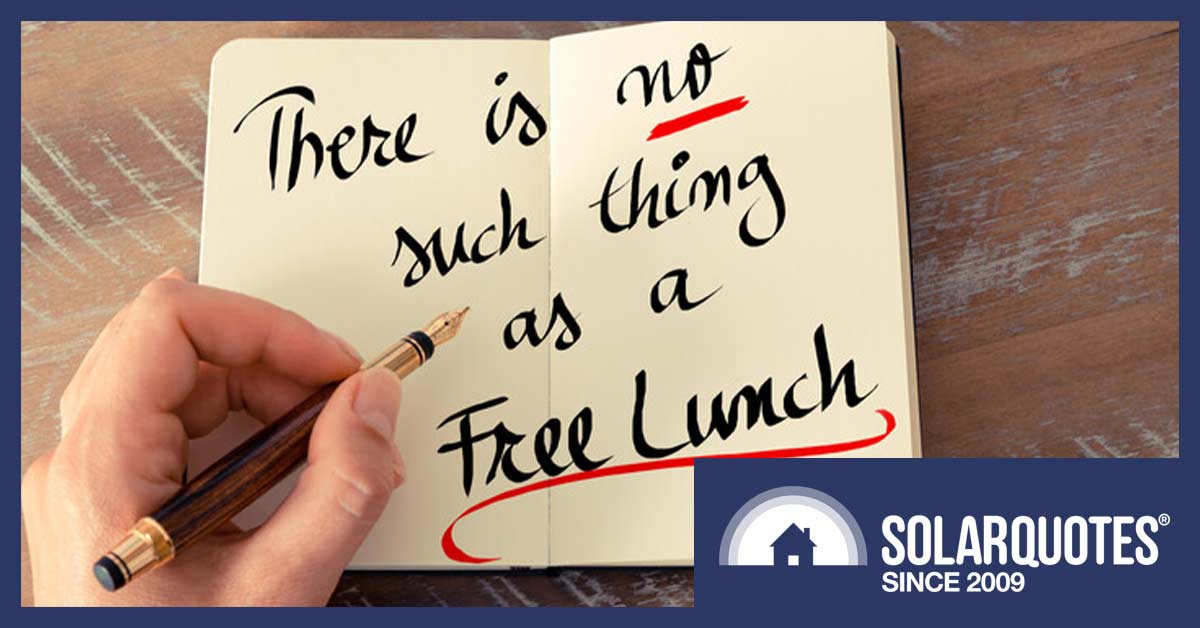

Energy Australia — the country’s third largest electricity retailer — is offering to install a solar and battery system for no money upfront, provided…
- You live in an owner-occupied home in certain areas of NSW
- You consume at least 16 kilowatt-hours per day of electricity
They call this the ‘Solar Home Bundle’ and before I go any further, I’ll point out that “no money up front” is very different from “no money at all”. You will pay for the solar system and battery over 7 years through your electricity bills.
It doesn’t look like a good deal to me, and I’ll explain why. But it’s not an obviously disastrous deal and may appeal to some. If you want to go for it, knock yourself out. All I ask is you go with your eyes open and fully aware that you are potentially locking yourself into paying electricity prices well above market rates for more time than it took Leo Tolstoy to write War and Peace.

My great aunt was reading this book when it was struck by a piece of Nazi shrapnel. Luckily, she wasn’t hurt because no one gets through War and Peace.
Extracting Information From Horses’ Mouths
Information on the deal is on the official EnergyAustralia Solar Home Bundle page. Note that to get all the available information, you will have to follow links to other pages, such as the Terms & Conditions document and the Systems Contract document.
How It Works
If your application for the Solar Home Bundle is accepted, Energy Australia will install a rooftop solar system and a battery for no immediate cost. Instead, you’ll pay for it every month for seven years.
It’s different from the usual “buy now, pay later” arrangement because, instead of paying a fixed amount each month, what you pay is based on how much electricity you use. You will need to pay 30 cents per kilowatt-hour for that electricity. The price is the same whether the electricity comes from the solar panels, the battery, or the grid and is fixed for 7 years. There is also a 94 cent per day supply charge, which is not fixed and can increase1.
No Financial Benefit From Your Solar + Battery For 7 Years
Because there are retailer plans that will supply grid electricity for considerably less than this right now and potentially much less in the near future, I’m expecting you’ll be at a significant financial disadvantage for the full seven years if you take up Energy Australia’s Solar Home Bundle.
Where You Can Get It
EnergyAustralia isn’t offering their Solar Home Bundle to just anyone in NSW, but it is available to most people that meet their criteria. By entering addresses from across the state…


…I found it’s available in most towns and cities, including Wagga Wagga, Narrandera, and Broken Hill. But some rural locations, such as Mildura, Moree, and Lightning Ridge miss out.
Update 3:00pm 18th July 2022: At some point in the past few days — possibly after this article went live this morning — EnergyAustralia severely cut back on the number of locations where this deal is available. Rural locations such as Wagga Wagga, Narrandera and Broken Hill are out and there is only limited coverage in places such as Sydney. Eligibility appears to vary within suburbs, so the only way you can know is to enter your address on their site and hope they’ve got it right this time.
EnergyAustralia Solar Home Bundle Criteria
On top of living in the right place, you also have to meet a heap of eligibility criteria, such as not already having solar panels and being able to work outside an iron lung. Energy Australia spells them out here:
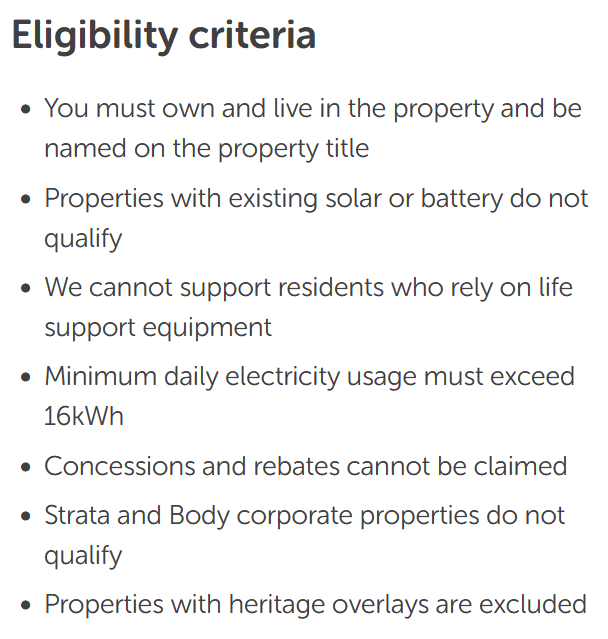

On top of these conditions, Energy Australia will only offer the deal to people they consider creditworthy.
16+ kWh A Day
One of the criteria above is your home must consume a minimum of 16 kilowatt-hours of electricity per day. Note they actually mean an average of at least 16 kilowatt-hours a day. While this is more than the typical home consumes, plenty of households consume this much or more. The 16-kilowatt-hour minimum does not apply to electricity consumed by hot water systems or other devices on controlled loads. EnergyAustralia will check your consumption habits.
There’s nothing to stop you from reducing your electricity consumption after you get the Solar Home Bundle, but large reductions probably aren’t a realistic option for most homes.
What You Get For No Money Down
When I said I wanted a solar system and entered a variety of locations on the EA website, I was told they would install a 5.67 kilowatt solar power system. Obviously, there must be room on your roof for a system that size, but there’s room for that much on most residential roofs. Here’s a screenshot of what Energy Australia said I’d get, taken directly from the horse’s website:


Note the “System Value” figure of $14,820 is not its value to you. That’s its value to EnergyAustralia. It’s how much you have to pay if you get the Solar Home Bundle and then immediately say, “Nah, I don’t want to be part of this deal anymore.” It declines over time in proportion to how much of the 7-year period is left.
It’s A Small Solar System
The 5.67 kilowatt solar system you get with the bundle is smaller than what I recommend for anyone with enough roof space. Generally, I suggest around 6.6 kilowatts as a minimum, but if it’s not difficult to install more then I recommend more.

More solar panel capacity is always good. Unless, of course, you are passing the current through your goolies like this chap.
This is because the extra capacity normally more than pays for itself, and it future-proofs the home against increases in electricity consumption, which will happen if and when an electric car is bought.
Solar Panels
The panels used by Energy Australia in the Solar Home Bundle will be one of two possibilities:
These are both reliable panels from manufacturers we can recommend, but they are low-cost solar panels. You won’t be receiving high-end panels with the bundle.
Combined Inverter & Battery
The battery system is a 10.1 kilowatt-hour Alpha ESS SMILE 5. Its usable capacity is 9.7 kilowatt-hours. The solar inverter is part of the battery system, which makes it an “all-in-one” that doesn’t require a separate inverter. This is one of the lowest-cost all-in-one battery systems available.
Warranties
The JA solar MBB solar panels have a 12-year product warranty. The only Trina panels matching EA’s description are Trina Vertex panels and they have a 15-year product warranty. But note, you don’t get to pick which panels are used, so you can’t choose the one with the longer warranty.
Both panels have a 25-year performance warranty.
The batteries of the 10.1 kilowatt-hour Alpha ESS system have a 10-year warranty, but the rest of the system only has five years warranty. This means — according to the battery systems warranties — if you own the battery system and the hybrid inverter part breaks down after 5 years, you won’t be able to use the batteries unless you pay out of pocket for the hybrid inverter to be repaired or replaced.
Warranty Transfer
When the solar power system and battery become your property, either when the seven years are over, or you pay to end the deal early, any remaining warranty will be transferred to you. Note this means, apart from its batteries, the Alpha ESS SMILE5 won’t be in warranty if you buy your way out after five years.
Energy Australia says they will make every effort to have the warranties transferred over, but doesn’t guarantee it. This is because it’s possible for the manufacturers to disappear and take their warranty support with them.
I think Australian Consumer Law may have something to say about that, but I’m not a lawyer.
Repairs & Maintenance
As the solar system and battery belong to EnergyAustralia for seven years, they are responsible for repairs and maintenance within that period. Once ownership is transferred, it’s all up to the owner.
No Guaranteed Backup
The Alpha-ESS SMILE5 should be able to provide backup power, but no mention is made of this in any Home Solar Bundle documents.
Before getting the Solar Home Bundle, I recommend confirming with Energy Australia that your battery will be able to provide backup power during a blackout.
What You Don’t Get
Despite having a solar system and battery installed, for the seven years of the deal, you won’t get:
- Any financial benefit from having solar.
- Any financial benefit from having a battery.
- Any financial benefit from being part of a VPP.
In addition, you won’t be able to change to a cheaper electricity plan for seven years. Right now, there are plans available that charge much less than the 30 cents per kilowatt-hour the Home Solar Bundle charges. For example, AGL’s Residential Flexible Saver is 22.24 cents per kilowatt-hour.

I’ve searched different areas, and it always says the charge per kilowatt-hour is 30 cents.
There is a supply charge of 94 cents per day, which is not fixed and can increase.
30 Cents Per kWh Isn’t Cheap
The 30.02 cents households pay with the solar home bundle is 7.78 cents more than the 22.24 cents AGL is currently offering. While not an extreme difference, it does add up. For a home that consumes an average of 20 kilowatt-hours per day it will result in the home paying $568 a year more. That comes to $3,976 over 7 years. Even if a home averages only 16 kilowatt-hours of electricity consumption per day — the minimum the plan allows2 — then the extra amount that will have to be paid is:
- Annually: $455
- Over 7 years: $3,183
However, even if you only consume the minimum amount, I expect the extra amount you’ll need to pay for electricity will be more than this because I’m expecting electricity prices to fall.
Lower Electricity Prices Likely
Electricity prices are currently high, and — provided we avoid a major economic slowdown — I expect they’ll remain high next financial year. Depending on how long current high wholesale electricity prices last, they could rise even higher next year.
But after that, I expect a large drop from their current high levels. It’s impossible to know for certain, but I would not be surprised if electricity prices over the next 7 years average 4 cents or more lower than they are now. This would mean those with the Solar Home Bundle would pay an average of around 12 cents more per kilowatt-hour for 7 years.
What If I Want Out?
You can exit the Solar Home Bundle deal any time you want — provided you fork over money to Energy Australia. The amount is $14,820 when it’s first installed and steadily declines by $5.80 a day until it’s $0 after 7 years. Here’s the exit charge after each full year has passed:
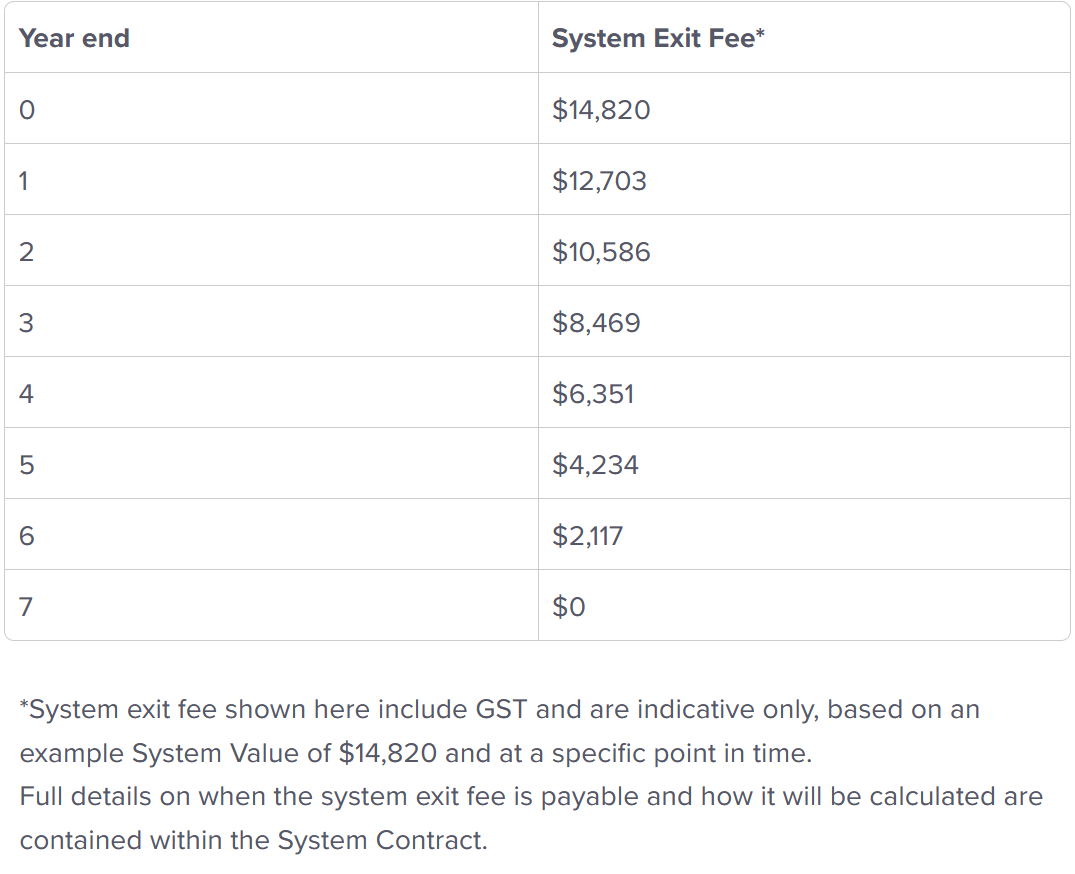

What If I Don’t Want Out?
After seven years the deal ends, and ownership of the system transfers to you, whether you want it to or not. But I think you’d have to be kind of nutty not to want the deal to end, because — apart from (hopefully) backup power — it gives no benefit.
What If I Want To Move?
You must pay the exit fee to EnergyAustralia if you sell your home before the seven years. This means getting the Solar Home Bundle is a bad idea unless you are confident you’ll stay where you are for seven years. Of course, seven years is a long time, and people’s situations change, so you should consider this risk before committing.
No Concessions!
While the 7-year deal is in place, the household can’t use any concessions for electricity. This means if you have a concession or think you’ll become eligible for one due to age or reduced income, it makes the deal worse for you. This is a bit of a problem because older people are more likely to be confident they’re not going to move for a long period, but are more likely to become eligible for energy concessions.
It’s Not A Great Deal
In my opinion, EnergyAustralia’s Solar Home Bundle is a poor deal because:
- For seven years, you will probably pay considerably more for electricity than you have to.
- Aside from its batteries, the warranty on the 10.1 kilowatt-hour Alpha-ESS SMILE5 is only 5 years, so it will be out of warranty when you finally get to own it.
If the price of electricity over the next seven years averages only around 3 cents lower than it is now, and the average savings that could be obtained from using other electricity plans comes to 11 cents per kilowatt-hour, then the extra amount on electricity bills over seven years will be:
- 16 kWh Average Daily Electricity consumption: $4,500 extra
- 20 kWh Average Daily Electricity consumption: $5,625 extra
- 24 kWh Average Daily Electricity consumption: $5,523 extra
If you end up paying $5,000 more than you need to for electricity, then you will have effectively paid that much to receive:
- A 7-year-old, 5.67 kilowatt solar power system (smaller than what most homes should install).
- A 7-year-old, out-of-warranty battery system.
As I expect the cost of both solar and batteries to fall over the next 7 years, and because I think they’ll also improve in quality, I think a household is likely to be better off saving $5,000. They could use that to buy a large brand new solar system or put it towards a new solar and battery system. In 7 years’ time it may even be possible to buy a good quality solar system and a battery for that much.
But waiting 7 years to get a solar power system is a bad idea. Because home batteries don’t yet provide a clear financial return in NSW — at least not for any household with near normal electricity consumption — it will make much more sense to get rooftop solar now and put off getting a home battery until it’s clearly worthwhile.
Get Your Own Rooftop Solar Panels
A household can be in a much better position if it gets its own rooftop solar because it will provide an immediate benefit without waiting 7 years for savings. It’s unclear how much it will save over seven years, as it will depend on what happens with electricity prices, solar feed-in tariffs, and the amount of solar energy the home self consumes.
But for a home that uses an average of over 16 kilowatt-hours a day, a 6.6 kilowatt solar system can save well over $1,000 a year. If the savings average to $1,000 a year over 7 years, then a household could have a good quality system installed for $5,000 and come out $2,000 ahead.
The advantages of getting your own solar system are:
- It can be larger than 5.67 kilowatts.
- Solar energy can be consumed during the day instead of grid power.
- Surplus solar energy can be sent into the grid for a feed-in tariff.
- The solar inverter will still have warranty remaining after 7 years.
- Immediate savings on electricity bills.
The drawback is you will have to pay for it. But the benefits of solar power are so large that if you can’t pay for it out of pocket, it can make sense to finance it.
If, thanks to the financial benefits of solar and paying less for grid electricity, a household is $6,000 better off after 7 years and also has a larger and better warranted solar power system, I’d say they would be in a much better position than the alternative of owning a smaller solar system and an out of warranty battery system.
Getting A Solar Battery Now
Generally speaking, a home battery isn’t going to pay for itself for normal NSW households at the moment. But if you can make it work for you, or you want one for non-financial reasons, then please get one as it will help lower electricity prices for others and aid the integration of renewable energy.
If you do get a battery system now, in addition to the usual benefit of storing solar energy for use at night, it’s also possible to receive payments from joining a Virtual Power Plant (VPP). How much financial benefit these provide varies and their terms are confusing, but if they provide an average of $250 net benefit a year, then over 7 years, that would come to $1,750.
Getting An EV
Many people will buy electric cars in the near future, which will considerably increase the amount of electricity homes consume. An EV driven the average pre-pandemic distance of 38 km a day will increase a household’s electricity consumption by around 7 kilowatt-hours per day or 2,500 kilowatt-hours a year. So, if a household gets an electric car while paying 30 cents for every kilowatt-hour of electricity because they’re on the Solar Home Bundle deal, it will add a hell of a lot to electricity bills.
How much extra will depend on how the EV is charged. Because homes could charge it with energy from their own solar system and/or off-peak electricity, charging an EV could be 20 cents or more cheaper. The amount of money saved annually by not paying Solar Home Bundle prices for charging an EV that consumes 2,500 kilowatt-hours will be:
- 7 cents cheaper per kilowatt-hour: $175
- 11 cents cheaper per kilowatt-hour: $275
- 15 cents cheaper per kilowatt-hour: $375
- 20 cents cheaper per kilowatt-hour: $500
So, if a home buys an EV two years after getting the Energy Australia Solar Home Bundle and has to pay an average of 15 cents more to charge it than they would otherwise, over the remaining 5 years of the deal it would cost them an extra $1,875. If they bought an EV after one year and liked it so much they bought a second one a year later it would end up costing them an extra $4,125.
V2H & V2G Is Coming (I Hope)
At the moment, it is difficult and expensive and often impossible to use an EV to power a home (V2H) or supply power to the grid for payment (V2G)3. But this is likely to change over the next few years. Unfortunately, while you’re on the Solar Home Bundle deal, it will be impossible to take advantage of them.
EnergyAustralia’s Deal Will Appeal To Some
Here’s a summary of why I don’t think the Energy Australia Solar Home Bundle is a good deal:
- It locks you into paying a high price for all electricity consumption for 7 years and I’m expecting electricity prices to fall within two years.
- The solar power system is smaller than I recommend for most households.
- The battery system will be out of warranty if ownership is transferred after 5 years.
- Moving or using energy concessions will require you to pay an exit fee.
- Buying a solar system of your own can provide much greater benefit and can be financed if necessary.
- There’s no guarantee the battery will be able to provide backup and VPP payments can’t be received.
- Getting an EV or otherwise increasing electricity consumption can greatly increase costs, and it won’t be possible to take advantage of V2H or V2G.
The deal seems pretty lousy when I put it like that, doesn’t it? But it may not turn out as bad as I make it sound. If I am wrong about electricity prices, and they head up on average over the 7 years instead of down, then the Solar Home Bundle could turn out to be a good deal. I think this is very unlikely to happen, but it’s not impossible. Inflation could end up much higher than I or Energy Australia expect.
The deal will also appeal to people who want a battery now but don’t want to pay upfront. My advice for most households is to get solar now and put off getting a home battery until it’s clear it will pay for itself. But if you want a battery right now and can’t pay for it, this deal will let you get one. That said, if EnergyAustralia thinks your credit is good enough for you to participate in their Solar Home Bundle deal, your credit is probably good enough for you to finance your own battery.
One advantage I can see is many home battery systems still have teething problems in their first year of operation, so any early issues will be Energy Australia’s problem.
My advice is to think hard before signing up. Do you want to be financially handcuffed to one of the big energy retailers for seven years? In my opinion, most homes are probably much better off steering clear of the EnergyAustralia Solar Home Bundle. But if you do decide it’s worthwhile, you will be helping the rest of us out by getting a battery — even if you don’t see any financial benefit for seven years — so I’ll thank you for that in advance.
Footnotes
- but EA promise it will only increase in line with supply charge increases for other Energy Australia retail plans in NSW ↩
- As mentioned, that is not what EnergyAustralia said in their criteria summary, but that was just a stupid misteak. ↩
- There’s an exception with some EVs that allow you to plug an extension cord into them and run things off its battery that way. But if you can afford a new EV, you can probably also afford a dedicated home battery, so you don’t have to try to run appliances off a car extension cord. ↩
Original Source: https://www.solarquotes.com.au/blog/ea-solar-home-bundle-review/

